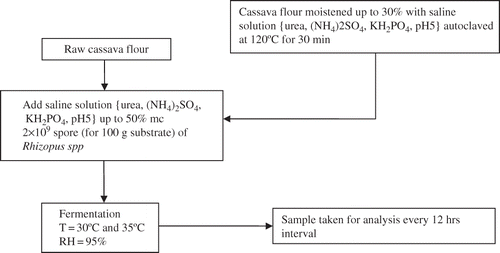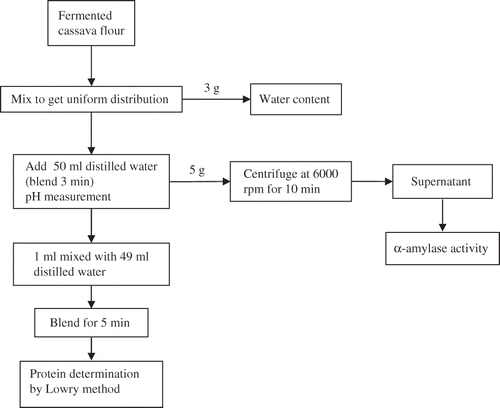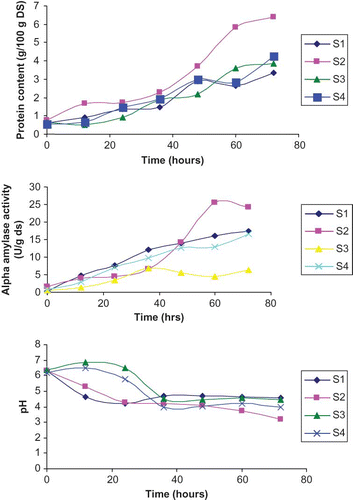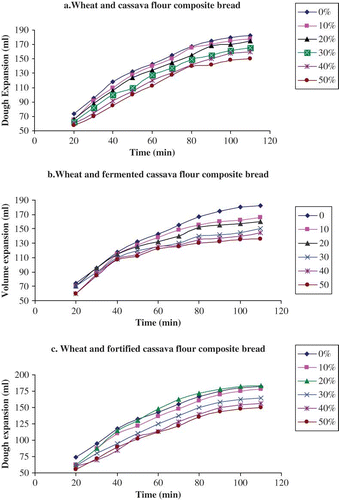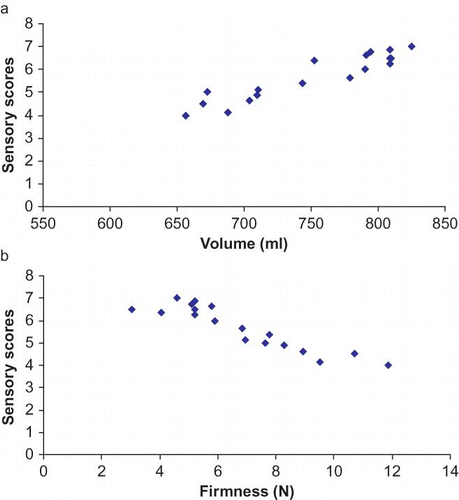Abstract
Formulation of fungal protein enriched breads containing up to 20% fermented cassava flour showed non-significant difference from 100% wheat flour bread. Maximum substitution of 30% cassava flour fortified with soy protein was possible which improved baking properties of bread as well as sensory scores and reduced the staling rate. Alpha-amylase in fermented cassava flour reduced the change in firming rate during storage but fungal protein did not help in baking properties of bread. Strong correlation between sensory scores and instrumental measurement proved that wheat flour can be replaced partially by cassava flour in the composite bread preparation by applying fermentation and soy protein fortification techniques.
INTRODUCTION
Cassava is one of the most important tropical root crops in developing countries. Its starchy roots are a major source of dietary energy for more than 500 million people.[Citation1] It is known to be the highest producer of carbohydrates among staple crops. However, cassava is carbohydrate-rich but low in protein, so people who eat only cassava suffer from malnutrition. Protein deficiency exists in about 60% of the world, particularly in the developing countries.[Citation2] Many regions that are actually deficient in protein have an adequate supply of carbohydrates, usually in starch form. The conversion part of starch into protein by microbial fermentation is being explored.[Citation3] This protein could improve the protein-calorie balance of people in these poor countries. A practical approach would be to enrich cassava with protein by means of a simple technology, such as solid-substrate fermentation. Protein could be synthesized by micro-organisms growing on solid cassava flour without maintaining aseptic conditions so that other micro-organism could not grow in this media. Filamentous fungi are mostly used in solid-state fermentation. Several Rhizopusspecies provided considerable interest for food industry. They have been used in solid-state fermentation for several countries, especially in Asia such as China, Korea, Japan, Indonesia, Malaysia and Singapore for preparing many fermented foodstuffs.[Citation4,Citation5] Rhizopus species not only enhances the digestibility and protein content of foodstuffs,[Citation6–9] but also prevent the formation of the toxic substances such as aflatoxin B1.[Citation10] They can produce numerous anti-carcinogenic substances[Citation11] by synthesizing an antibiotic that is extremely active against a large number of gram-positive bacteria[Citation12] and detoxify cassava cyanogenic glycisides.[Citation13]
Currently, people are more interested in ready-to-eat food. As food material, bread has several advantages such as convenience, storage qualities and balanced nutrients. The habit of eating bread made from wheat has spread throughout the world. In order to reduce excess pressure on wheat, non wheat staple crops can be used instead of wheat. Fermented cassava flour as it is rich in protein can be supplemented to wheat flour and this could fortify bread. This study was conducted to determine the change in physicochemical properties of fermented cassava flour and the effect of fermented cassava flour on composite breads. The composite flour bread characteristics during storage were also studied. In addition, bread quality (volume, firmness, peak viscosity) was determined by instrument, which was correlated with sensory evaluation.
MATERIALS AND METHODS
Materials and Strains
This study was conducted in the laboratories of the Asian Institute of Technology, Thailand. Cassava flour supplied by Tong Jan Ltd., Thailand and strains (two Rhizopus oryzae and two Rhizopus delemar) for fermentation was obtained from Thailand Institute of Scientific and Technological Research (TISTR). Other ingredients were procured from local market.
Sporangiospore Production
Four Rhizopus strains were studied in this experiment. The tested strains Rhyzopus oryzae (TISTR 3052), Rhizopus oryzae (TISTR 3058), Rhyzopus delemar (TISTR 3534) and Rhyzopus delemar (TISTR 3190) were inoculated on potato dextrose agar media plate. After culturing the strain for eight days at 28°C spores were collected by using loops to scrape out of petridish agar surface. Spores were suspended in tubes containing sterile physiological saline solution (0.9% NaCl) with 0.01% Tween 80 solution.
Solid State Fermentation
Collected spores were inoculated in raw cassava flour and cooked cassava flour as shown in . Volume of spore solution added depended on concentration of spores. Initial pH was adjusted to 5.0. The mixture was incubated in the control relative humidity chamber for 72 h. Sample was collected every 12 h and analyzed for moisture content, protein content, pH and α-amylase activity ().
Bread Preparation
Yeast-leavened composite bread was developed from the commercial formulation, adjusted to 260 g dough (). In the production of composite breads the amount of cassava flour, fermented cassava flour and fortified cassava flour levels included 10, 20, 30, 40, and 50% of total flour. At first the yeasts was rehydrated to ferment in warm (40°C) water (8 ml/g dry yeasts) for 10 min. Salt and sugar were dissolved in the remaining water according to . The remaining dry ingredients were then transferred into the dough mixer. The dough was mixed first two minutes at low speed and next 10 minutes at medium speed. The resulting dough was first proof for one hour and 20 minutes in the proof cabinet at 28°C. The relaxed dough was then divided into dough portions. Next, the divided dough was manually rounded up and first proofed for 15 min. Then the dough was manually molded and placed in the baking pan. The panned dough was next proofed at 28°C instead of 40°C for 30 min. The method used was modified method of Khanitta.[Citation14] The leavened dough was baked in the ready heated oven for 25–35 min at 200°C.
Table 1 Ingredients used for preparing bread
Analytical Methods
Proximate compositions of raw cassava flour, fermented cassava flour and bread crumb were determined by AOAC.[Citation15] The crude fiber of sample was determined by Fibertec System consisting of Hot Extraction Unit 1020 and Cold Extraction Unit 1021.[Citation16] Protein content was measured by Lowry Assay.[Citation17] Amylose content was measured by using DMSO-Iodine complex.[Citation18] α-amylase activity in fermented cassava flour and pH were measured according to Soccol et al.[Citation7] The pasting properties of samples were measured using Rapid Visco Analyser (The series 4 RVA Newport Scientific Pty. Ltd., Australia). Measurement was based on the method of Guha et al.[Citation19]
Bread Evaluation
Loaf volume was determined by starch pearls replacement and the specific volume was obtained by dividing loaf volume by its weight. The prepared bread was placed in a known volume container and the remaining gap was filled with starch pearls. The volume of the bread was determined by deducting the volume of starch pearls from the total volume of the container. Dough expansion was measured by using the method used by Khanitta.[Citation14] 50 g dough was placed in a measuring cylinder and compressed well before testing. Cylinder was placed in a cabinet at 28°C and volume increase was recorded at every 10 min for 110 min. Bread firmness and springiness were determined according to the standard method published by AACC method using a Texture Analyzer.[Citation20]
Sensory and Instrumental Evaluations
The composite flour breads were evaluated for the acceptability of color, aroma, grain, taste, texture, and overall preference by the hedonic 9-point scale where 9 represents extremely liked and 1 extremely disliked. The nine untrained panelists were the Food Engineering and Bioprocess Technology students of AIT, Pathumthani, Thailand, ranging in age from 20 to 30 years. The panelist was selected by triangle test. They tested similar size (2 cm × 2 cm) wheat bread, cassava flour composite bread (wheat flour was replaced by cassava flour from 10 to 50%), fermented cassava flour composite bread (wheat flour was replaced by cassava flour from 10 to 50%) and wheat cassava flour composite bread enrich by soy flour separately. Here panelist compared different types of cassava flour composite bread with 100% wheat flour bread as control. They evaluated the coded samples in a room alone where the bread samples were served on the plastic dishes under day light condition. With respect to sensory evaluation, the same size of bread samples was also tested for the instrumental textural profile analysis (TPA) on the basis of hardness, springiness, cohesiveness, gumminess, and chewiness by using an appropriate program in the Food Materials Testing Machine (Instruments model LRX 5K, LLOYD Instruments Ltd.). A 10 cm diameter stainless steel thin plate attached to the Food Material Testing Machine and equipped with 50 kg load cell with the cross head speed of 20 mm/min was used to compressed bread pieces to 60% of their original height. The bread sample was compressed twice to give a two bit textural profile curve.
Statistical Analysis
The difference between treatment means were analyzed using one way and two-way analysis of variance (ANOVA) at a 0.05 significance level. Duncan's Multiple Range Test (DMRT) was used to compare treatment means, if a significance difference was detected at 5% level of significance. Unless otherwise mentioned all the measurements were made in triplicate and the values represents the average of three measurements.
RESULTS AND DISCUSSION
Effect of Temperature and Cassava Flour on Fungal Growth
Cassava flour were gelatinized with same saline solution at 121°C for 30 min and inoculated with same inoculums size. Four fungal strains viz Rhizopus oryzae (TISTR 3052), Rhizopus oryzae (TISTR 3058), Rhizopus delemar (TISTR 3534) and Rhizopus delemar (TISTR 3190) were cultivated on raw and cooked cassava flour substrates for at 30 and 35°C (). All strains grew better in cooked substrate (). The better and the best fungal growth were observed on cooked cassava substrate at 30 and 35°C, respectively than that of raw cassava flour as indicted by the production of protein and alpha amylase activity (). However, Rhizopus oryzae (TISTR 3052) gave higher α-amylase value at 30°C. At both the temperatures, the higher protein content and α-amylase activity were observed on the 72nd hour. It may be happened as micro-organism preferred gelatinized starch. It could easily breakdown the cooked substrate and consumed sugar as food. Rhizopus oryzae (TISTR 3058) grew better on cassava flour and produced the highest amount of protein (7.7 g/100 g dry sample) and α-amylase activity (27.5 U/g dry sample) in gelatinized cassava flour substrate at 35°C, which was therefore chosen for further experiments.
Table 2 Growth kinetics of Rhizopus strain on the basis of α amylase activity and protein production
Protein Content, α-Amylase Activity, and pH
Protein content, α-amylase activity and pH of fermented cooked cassava at 35°C were observed at 12-h intervals. The general pattern of protein and α-amylase activity production with incubation time closely followed the pattern of fungal growth (). In case of cassava fermented by Rhizopus oryzae (TISTR 3058), rapid production of protein and α-amylase activity occurred from 24 to 60 h, with values ranging from 1.71 to 5.82 g/100 g dry sample (DS) and 4.4 to 26.8 U/g DS, respectively. After 60 h protein production was slower and α-amylase activity was decreasing. Therefore, harvesting time could be in between 60 to 72 h. The pH of a culture may change in response to metabolic activities. The most obvious reason was the secretion of organic acids such as, citric acid, acetic acid or lactic acid and ammonium salt consumption which would cause the pH to decrease. In the experimental results Rhizopus oryzae (TISTR 3058) reduced pH from 6.3 to 3.2 () with simultaneous rapid increase of protein. Rhizopus delemar (TISTR 3190), Rhizopus delemar (TISTR 3534), and Rhizopus oryzae (TISTR 3052) reduced the pH of substrate to 3.94, 4.43 and 4.56 respectively. Initial increase of pH occurred in case of Rhizopus delemar (TISTR 3190) and Rhizopus delemar (TISTR 3534). This might be due to the utilization of ammonium ions by the fungi leaving the cations in the medium.
Physicochemical Properties
Rhizopus oryzae increased the protein and total nitrogen content of cassava flour from 0.68 to 14.9 g/100 g dry sample through the fermentation technique (). The increase in protein content might be due to the fact that Rhizopus oryzae, degraded cassava product readily,[Citation21] and secreted extra cellular enzymes in substrate which consequently increased the protein content of the flour, as well as microbial biomass. It was also observed that fermentation increased the fat, fiber but relatively lower amount, however it increased considerable ash content. Fermentation lowered the amylose content from 18.40 to 16.06%. This may be due to the presence of different enzyme which could break linear chain of amylose and reduced the percentage.
Table 3 Physicochemical properties of native flours and fermented flour
Pasting Properties
Pasting characteristics of native cassava flour, wheat flour, cooked with water, cooked with mineral solution and fermented flour were evaluated by Rapid Visco Analyser (RVA) presented in . Pasting properties of tested flours were significantly different from each other. The difference in pasting properties of native flours appears due to the different components of flours especially protein, lipid, amylose and amylopectin contents. All pasting properties (trough viscosity, final viscosity, pasting temperature and peak time, peak viscosity, and break down) of cassava flour are higher than that of wheat flour but set back is lower than wheat flour. This may be because wheat flour has higher protein, lipid and fiber. Heat treatment of cassava flour increased trough viscosity, final viscosity, setback pasting temperature and peak time but decreases its peak viscosity and break down. Peak viscosity of cooked starch decreased due to the rearrangement of granular structure of starch during heating with water. Further decrease in peak viscosity in case of gelatinized with mineral solution was due to salt. Pre-gelatinization provides a cold soluble substance that gives high cold paste viscosity rather than a gelatinization peak.
Figure 4 RVA profiles of different cassava flour samples and wheat flour by a heat-hold-cool cooking cycle. (Figure provided in color online.)
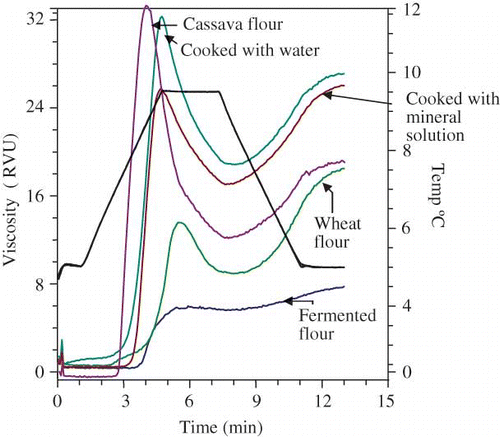
Fermentation markedly reduced all of the pasting parameter of cassava flour. It gave lower level of peak, final viscosity and setback but higher pasting temperature. This may be happened due to the protein content of fermented flour. Besides, during fermentation α-amylase broke starch long chain, formed small chains, and reduced total starch content. Similar results were also found by other scientists that fermentation, blanching and drying modified the rheological properties of the cassava starch and flour, which produced more retrogradation and reduced viscosity, together with an increased swelling power.[Citation22,Citation23,Citation24]
Composite Bread Evaluation
Three types of composite bread were studied to evaluate their instrumental textural properties and sensory quality. Cassava flour was used to ascertain the possibility of reducing wheat content in bread and to replace with locally available cassava flour in composite bread. The nutritional value of this kind of bread was improved by using fermented cassava flour. Finally to improve the quality soy protein fortified cassava flour used in composite bread. 10–50% cassava flour was used for each experiment. Volume and specific volume of composite bread containing 10 to 20% substitution of wheat flour by cassava flour and fermented cassava flour had no significant difference from 100% wheat flour bread (). Soy protein (up to 6.4%) improved the baking properties of composite bread. In terms of volume and specific volume 20% enriched (by soy protein) cassava flour in dough gave best bread and up to 30% enriched cassava flour substitution of wheat flour was possible. Wheat flour contains gliadin and glutenin protein, which helped forming viscoelastic dough. This dough retained gas during fermentation and early stages of baking. After starch gelatinization and protein coagulation the dough changed into high raised and elastic bread. The reduced volume and specific volume of composite bread was associated with the absence of gluten in cassava flour. The composite flour dough formed weak viscoelastic network that could not retain enough gas during fermentation and baking like wheat dough. Dough containing 30 to 50% cassava flour showed abnormal crust. Fermented cassava flour with protein content of 6.4 g/100 g dry sample did not produce bread with improved properties as compared to raw cassava. This may be happened because the protein obtained on fermentation does not have properties of gluten protein in wheat but certain amount of soy protein helped to improve the baking properties of composite bread. Firmness of bread increased with the increase of cassava flour substitution whereas springiness decreased ().
Table 4 Effect of levels of native and treated cassava flour on bread texture change during storage
Figure 5 Volume and specific volume of composite bread. *wheat bread. S1: wheat and cassava flour composite bread; S2: wheat and fermented cassava flour composite bread; and S3: wheat and cassava flour fortified with soy protein.

Dough expansion was measured in terms of dough volume at every 10 minutes interval. Wheat and cassava composite dough expanded faster than other combination and composite flour dough expansion decreased with the increase of cassava flour ratio. Twenty percent cassava flour substitution seemed minimal than that of other levels. Fermented cassava flour dough showed less expansion levels than that of non fermented cassava flour. Twenty percent soy protein enriched cassava flour substituted dough showed little bit higher expansion than that of wheat dough ().
Effect of Storage on Bread Structure
Composite bread firmness increased and springiness decreased with the increase of storage time (). Higher substitution level of cassava flour resulted in faster firming in general. Bread containing 10% fermented cassava flour was the most soft after three days of storage. Soy protein enrich flour decreased the firming rate and springiness of bread. Soy protein also improved bread storage characteristics and 10–30% substituted bread was softer than that of wheat bread ().
Sensory Evaluation and Instrumental Measurement
The acceptability of composite wheat flour breads was determined in terms of sensory evaluation. Six parameters were considered under organoleptic tests including crumb colour, grain, aroma, taste, texture and overall acceptability. It was observed that most of ogranoleptic characteristics also decreased with the substitution level increased. Overall acceptability of wheat-cassava flour and wheat-fermented cassava flour bread were disliked slightly to like slightly (4.5–6.8) and disliked slightly to like slightly (4.0–6.2) respectively. Up to 20% substitution was acceptable for both type of composite bread. On the other hand, soy protein fortified composite bread was neither liked nor disliked moderately (5.0–7.0), and 30% substitution was accepted by the panelist (). Sensory scores, baking properties and instrumental measurement of formulated bread were good and correlated with each other. Volume, specific volume, springiness and sensory scores like taste, texture and overall acceptance were positively correlated ( and Fig. ), but negatively correlated with hardness ( and ).
Table 5 Sensory evaluation of composite bread
Nutritive Value of Composite Bread
Twenty percent cassava flour addition in composite bread reduced its nutritive value specially protein content (10.53%) than that of wheat flour (13.39%). But higher protein content was found in fermented (12.33%) and soy protein fortified cassava flour (12.24%) which can be used for composite bread preparation (). It had also higher percentage of fat and fibre.
Table 6 Nutritional values of composite wheat and cassava flour breads
CONCLUSION
Twenty percent cassava and fermented cassava flour composite breads were acceptable in terms of sensory evaluation but higher amounts of substitution gave unsatisfactory score and baking quality. α-amylase in fermented cassava flour reduced the rate of change of firmness during storage. Soy protein fortification (u p to 30%) in cassava flour improved bread quality in terms of baking properties, textural properties and organoleptic characteristics, which was accepted by the panelist. Thus substitution of wheat flour with cassava flour in bread formulation is possible by applying fermentation and soy protein fortification techniques.
REFERENCES
- Zakhia , N. , Chuzel , G. , Brabet , C. and Dufour , D. Cassava fermentation: Cassava sour starch in Latin America . In the cassava biotechnology network. Volume II. Proceeding of the second international scientific meeting . Bogor , Indonesia. pp. 651 – 671 .
- Strasser , J. , Abbott , J.A. and Battey , R. 1975 . F. Process Enriches Cassava with Protein . Food Engineering , 42 : 112 – 116 .
- Noomhorm , A. , Ilangantileke , S. and Bautista , M.B. 1992 . Factors in the Protein Enrichment of Cassava by Solid State Fermentation . J. Sci. Food Agric. , 58 : 117 – 123 .
- Hesseltine , C.W. 1965 . A Millennium of Fungi, Food and Fermentation . Mycologia , 57 : 149 – 197 .
- Raimbault , M. 1981 . Fermentation en Milieu Solide: Croissance de Champignons Ilamenteux Sur Substrats Amylaces. Edited by: ORSTOM-Paris . Serie Travauxed Documents , 127 : 291
- Soccol , C.R. 1992 . Physiologie et Métabolisme de Rhizopus en Culture Solide et Ubmergée, en Relation Avec la Dégradation D'amidon Cru et la Production D'acide L(+) Actique , 219 France : PhD Thesis, Université Technologique de Compiègne .
- Soccol , C.R. , Cabrero , M.A. , Roussos , S. and Raimbault , M. Selection of Rhizopus or Growing on Raw Cassava . Guerrero R (red) Proceedings of the VI International Symposium on Microbial Ecology . Bareclona . pp. 6 – 11 . 302
- Cook , J.H. 1982 . Cassava: A Basic Energy Source in Tropic . Science , 218 : 755 – 762 .
- Beuchat , L.R. 1987 . Food and Beverage Mycology , 2nd , New York : Van Nostrand Reinhold .
- Ko , S.D. 1988 . Shelf Protection of Fermented Foods against Aflatoxin. Proceedings of Fats By Immobilized Fungus at Constant Water Concentration . J. Ferment. Techno. , 66 : 567 – 575 .
- Zhu , C.R. , Du , M.J , Lei , D.N. and Wan , L.Q. 1989 . A Study on the Inhibition of Aflatoxin B1-Induced Hepatocarcinogenesis by Rhizopus Delemar . Meter Med Pol. , 21 : 87 – 91 .
- Wang , H.L. , Ruttle , D.I. and Hesseltine , C.W. 1969 . Antibacterial Compound from a Soy Product Fermented by Rhizopus Oligosporus . Proc Soc Exp Biol Med. , 131 : 579 – 583 .
- Padmaja , G.B. and Balaglpal , C. 1985 . Cyanide Degradation by Rhizopus Oryzae . Can J Microbial. , 31 : 663 – 669 .
- Khanitta , M. 2000 . Effect of Emulsifiers on Composite Wheat, Rice and Brown Rice Flour Bread Characteristics , Pathumthani , , Thailand : AIT thesis no. PH-00-15 .
- Association of Official Analytical Chemistry . 1984 . Official Methods of Analysis , 13th , 1018 Washington , DC : AOAC .
- Fibretech system, User Manual, Rev. 2.2. Part No. 1001537.
- Lowry , O.H. , Rosebrough , J.N. , Farr , A.L. and Randall , R.J. 1951 . Protein Measurements with the Folin Reagent . J. Biol. Chem. , 193 : 265 – 275 .
- Win , S.S. and Oates , C.G. Use of Advance Spectrophotometric Procedure for Determination of Amylose in Cassava Starch and Characterization of Modified Starch . Bioprocess Internal Research Paper . Thailand . BPT, Asian Institute of Technology, Pathumthani 12120 .
- Guha , M. , Ali , S.Z. and Bhattacharya , S. 1998 . Effect of Barrel Temperature and Screw Speed or Rapid Viscoanalyser Pasting Behaviour of Rice Extrudate . International Journal of Food Science and Technology , 33 : 259 – 266 .
- American Association of Cereal Chemists . 1986 . Approved Methods of the AACC Method 74–09 , St. Paul , MN : The Association .
- Vlavonou , B.M. 1988 . Cassava processing technologies in Africa, 19–25, In praise of Cassava . Proceedings of the Interregional Experts’ Group Meeting on the Exchange of Technologies for Cassava Processing Equipment and Food Products, IITA . April 13–19 1988 , Ibadan , Nigeria. Edited by: Hahn , N.D. New York : UNICEF House .
- Dufour , D. , Larsonneur , S. , Alarcon , F. , Barbet , C. and Chuzel , G. 1996 . “ Improving the bread- Making Potential of Cassava Sour Starch ” . In Cassava Flour and Starch: Progress in Research and Development , Edited by: Dufour , D. , O'Brien , G.M. and Best , R. 133 – 140 . Montpellier , , France : CIRAD . CIAT: Cali, Colombia
- Onitilo , M.O. , Sanni , L.O. , Oyewole , O.B. and Maziya-Dixon , B. 2007 . Physicochemical and Functional Properties of Sour Starches from Different Cassava Varieties . International Journal of Food Properties , 10 ( 3 ) : 607 – 620 .
- Udensi , E.A. , Ukozor , A.U.C. and Ekwu , F.C. 2005 . Effect of Fermentation, Blanching, and Drying Temperature on the Functional and Chemical Properties of Cassava Flour . International Journal of Food Properties , 8 ( 1 ) : 171 – 177 .
